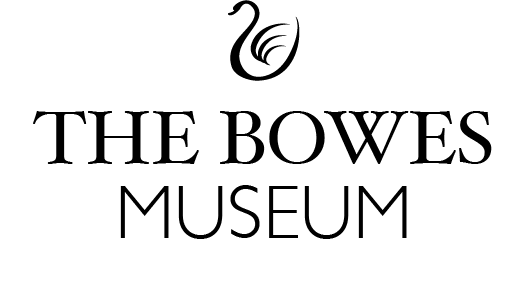
Mariana of Austria, Queen of Spain
Mariana of Austria (1634–96) was born in Wiener-Neustadt to Maria Anna of Spain (1606–46) and Ferdinand III (1608–57), King of Hungary from 1625, King of Croatia and Bohemia from 1627, and Holy Roman Emperor from 1637 until his death in 1657. Aged twelve, Mariana was betrothed to her cousin, Prince Baltasar Carlos (1629–49), at the court in Madrid, but after his sudden death she instead married her uncle King Philip IV (1605–65), who was nearly thirty years her senior. When Philip IV died in 1665 Mariana became Queen Regent, governing on behalf of her infant son, Charles II (1662–1700).
Mariana is depicted in the traditional mourning garb of a royal widow, consisting of white wimple (a dress with a head covering draped around her neck) and a black cloak. She holds a book in her left hand, a common symbol referring to authority and knowledge, and she rests her right arm on a throne-like chair, which serves as a symbol of her power and a reference to her duties as Queen Regent. The empty chair is also a reminder of her deceased husband, who no longer occupies it, and it also points to the future king, her son, who will occupy it when he comes of age. The portrait thus shows Mariana in her three roles as Regent, mother, and wife.
Coello has depicted Mariana against bright blue and gold drapery. The closed setting contrasts with the majority of representations of her during her regency, which show her in more complex palatial settings, as exemplified by the Portrait of Queen Mariana of Spain in Mourning by Juan Bautista Martínez del Mazo (1666, National Gallery, London). Mazo (c. 1612–67) was the son-in-law and student of Diego Velázquez and painted the first portraits of Mariana as a mourning widow.
Mariana’s regency was marred by political instability and economic decline. Her chosen male advisors were from Austria, which caused resentment at court. Her main detractor was John of Austria, illegitimate son of Philip IV, who in 1677 overpowered Mariana and imprisoned her in Toledo. Mariana returned to power after John’s death and continued to wield her influence over Charles II until her own death in 1696. The King’s disabilities were in part the reason why Mariana was able to exert control over her son. As a result of the Habsburg’s incestuous relationships, which they regarded as a mechanism for preserving the purity of their blood, Charles II was born physically and mentally ill, and was therefore unable to produce an heir.
Claudio Coello, one of most eminent artists of the late Baroque period in Madrid, was appointed court painter to Charles II from 1683. His production was mainly religious. The portrait was formerly attributed to Juan Carreño de Miranda (1614–85), who occupied the position of court painter to the King before Coello.
 Click to zoom and pan
Click to zoom and pan
...
Your feedback is very important to us. Would you like to tell us why?
We will never display your feedback on site - this information is used for research purposes.
Artwork Details
Title
Mariana of Austria, Queen of Spain.
Artist
Claudio Coello (Madrid, 1642–93).
Date
c. 1677–80.
Medium and Support
Oil on canvas.
Dimensions
104.5 x 84 cm.
Marks and Inscriptions
‘Salazar’ is written on the back of the painting, a possible reference to a former owner.
Acquisition Details
Bequeathed by John and Joséphine Bowes 1885.
Previous Owners
Purchased by John and Joséphine Bowes, possibly through Benjamin Gogué, Paris, from the collection of the late Conde de Quinto, 1862(?), cat. no. 35.
Institution
The Bowes Museum, Barnard Castle, B.M.69.
Bibliography
Enriqueta Harris, ‘Spanish Pictures from the Bowes Museum’, Burlington Magazine, 95 (1953, no. 598), pp. 22–25;
Juan Antonio Gaya Nuño, La pintura española fuera de España: historia y catálogo (Madrid: Espasa-Calpe, 1958), p. 129 (no. 529);
Eric Young, Four Centuries of Spanish Painting: 17th June – 17th September 1967, The Bowes Museum, Barnard Castle, County Durham (Gateshead: Team Valley Printers, 1967), p. 43–44 (no. 52);
Edward J. Sullivan, Baroque Painting in Madrid: The Contribution of Claudio Coello with a Catalogue Raisonné of His Works (Columbia MO: University of Missouri Press, 1986), p. 174;
Alfonso E. Pérez Sánchez, ed., Carreño, Rizi, Herrera y la pintura madrileña de su tiempo (1650–1700) (Madrid: Ministerio de Cultura & Banco Herrero 1986), p. 220;
Véronique Gerard Powell, ‘Spanish Paintings in the Bowes Museum’, in Spanish Art in County Durham, ed. Clare Baron and Andy Beresford (Bishop Auckland: Auckland Castle Trust, The Bowes Museum, & Durham University, 2014), p. 77.
